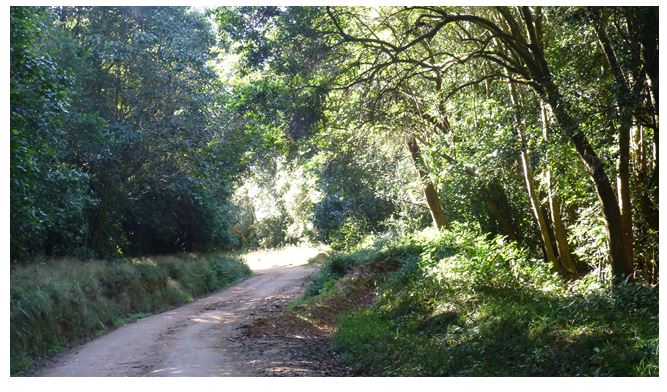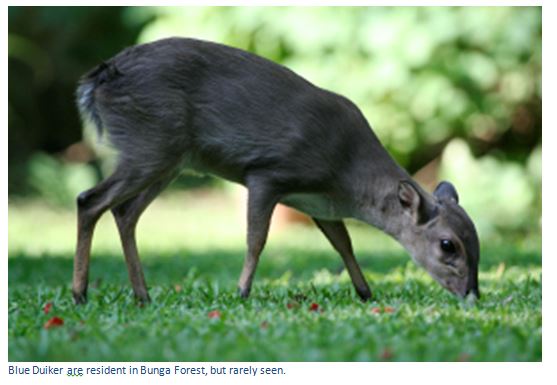Bunga Forest Botanical Reserve
- The Bunga Forest Botanical Reserve is on land that once belonged to the late Hon. Lionel Cripps, C.M.G., who was one of the foundation members of the Commission for the Preservation of Natural and Historical Monuments and Relics and left Bunga Forest to the nation.
- Bunga Forest is a dense indigenous rain forest, one of the most unique in Zimbabwe, with narrow pathways winding through it, in which you have the chance of observing rare bird species. You follow the path through the deep heart of the forest and eventually end up at the Bunga Views, an area of spectacular cliffs and Brachystegia woodland, overlooking the lower parts of the Forest and the Burma Valley.
From the Junction of Herbert Chitepo Street and Robert Mugabe Road in central Mutare take Robert Mugabe Road in an easterly direction, then turn right into Park Road continuing over the railway line and past the Beira Road turnoff into the industrial area, 3.35 KM turn left onto the Bvumba Road, 11.85 KM pass junction and continue on the Bvumba Road, 14.8 KM pass the Lauranceville Road on the left, 17.8 KM pass the Burmah Valley Road on the left, 19.2 KM pass the Burmah Valley Road on the right, 23.2 KM pass Bvumba Heights Road on the right, 26.6 Km enter Bunga Forest Botanical Reserve, 27.25 KM reach car park on the left
GPS reference: 19⁰06′50.69″S 32⁰46′03.23″E
The Bvumba, or Vumba as it was known (The word means “mist” in the local Manyika language as so many mornings start with a mist) together with the Chimanimani and Nyanga form part of the Eastern Highlands of Zimbabwe bordering Mozambique.The Bvumba are about 25 kilometres south east of Mutare and reached on a road that twists and turns, bends and curves up through the granite hills and keeping your eyes on the road isn’t easy with plenty of mountains views and scenic vistas of the Burma Valley below you. The driveways to private homes are marked with flower beds of hydrangea’s and intricate wrought iron gates. Huge forests of Eucalyptus trees blend with the indigenous flora of the Bunga forest reserve and the branches often fold over the road like arches. The highest point on the prominent granite batholith, Castle Beacon is at 1,911 metres (6,270 feet)
The seasons introduce a great variety of colour to any walk. When the msasa trees (Brachystegia / Miombo) unfold their new leaves a wonderful pallet of red and orange, green and yellows colours is revealed. At other times of the year, the path is moist, cool and lush and the trees and rocks are covered in ferns, mosses and flowering epiphytic orchids provide a beautiful contrast with the trees they grow in. The path, which leads you back to the main road, winds through sub-montane grassland.
The Bvumba Mountains are home to some of the rarest butterflies in the ecoregion and is a magnet for keen bird watchers out in search of rare species to tick on their lists. The area is probably best known as one of the main breeding areas of Swynnertons Robin which lives and breeds in small patches of forest. Livingstone’s Turacos (Tauraco livinstonii) are present, although they are often heard, but not seen.
A small number of mammals inhabit the Bvumba, including the leopard, samango monkey, bush pig, blue duiker and common duiker. The savannah woodland is home to several rare reptiles including Marshalls Leaf Chameleon (Rhampholeon marshalli) Arnolds Skink (Proscelotes arnoldi) and frogs.
The Bvumba Mountains, of which Bunga Forest Botanical Reserve forms a small part, was added to the UNESCO World Heritage Tentative List on August 20, 2008 in the Cultural category.




